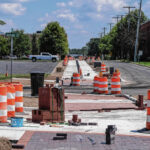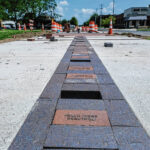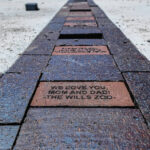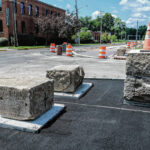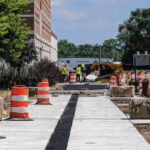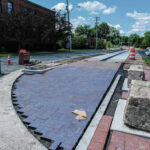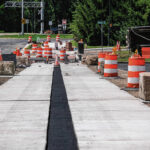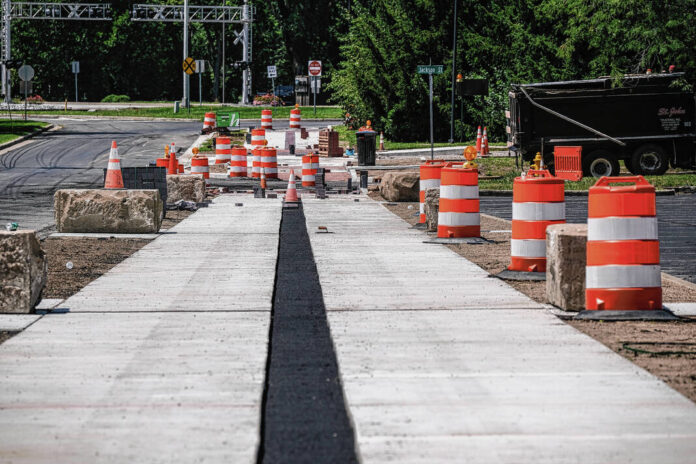
Mike Wolanin | The Republic A view of the 1821 Trail in downtown Columbus, Ind., Thursday, Aug. 11, 2022.
Construction on the 1821 Trail continues to move along, although the project’s timeline has been affected by various factors, including supply chain issues.
Redevelopment Director Heather Pope previously estimated that while landscaping would take place in November, the trail would be largely complete in August. However, the August estimate has been pushed back by about four weeks due to factors such as supply chain issues, weather and subcontractor delays.
Landscaping, on the other hand, is still expected to be installed sometime in November, and the city hopes to have a ribbon cutting ceremony once that piece is finished.
Despite the obstacles, Pope is happy about the progress of construction.
“We’re nearing the end, and it’s exciting to see the finished product — the bricks going down, the monuments where the markers will be located being placed,” said Pope. “And you can really get an idea of what it’ll look like.”
The city and Bicentennial Commission have called the 1821 Trail the “seminal project” of the 2021 bicentennial. According to officials, the trail extension will run from Water Street to Lafayette Avenue, connecting to the Haw Creek Trail. The project also includes architectural, historic and artistic elements.
Pope said that the portion of the project near the Robert D. Garton Veterans Plaza is “pretty much done.” Engraved bricks have been laid in the area, and workers will return to fill in spaces between the blocks.
The city sold about 500 engraved bricks for the trail project.
“I was pleased to see how many wanted to participate and … be a part of the community by having their names or messages displayed,” said Pope.
Some of the more creative inscriptions include a friendly “BIENVENUE” and “HELLO THERE, BEAUTIFUL!”
Another visible sign of the trail’s progress are the large pieces of limestone salvaged from the old railroad bridge in Noblitt Park that have been installed along the path. According to the department’s website, some will be used as benches and others will serve as bases for historic markers.
Pope said that while limestone bases are in place along the trail, the city expects it to be several weeks before the actual markers are built. Once these are in place, they will serve both a practical and cultural purpose.
“The trail markers are going to be internally illuminated,” she said. “And they’ll tell the last 200 years’ history.”
Mike Wolanin | The Republic A view of the 1821 Trail in downtown Columbus, Ind., Thursday, Aug. 11, 2022.
Mike Wolanin | The Republic A view an engraved brick on the 1821 Trail in downtown Columbus, Ind., Thursday, Aug. 11, 2022.
Mike Wolanin | The Republic A view an engraved brick on the 1821 Trail in downtown Columbus, Ind., Thursday, Aug. 11, 2022.
Mike Wolanin | The Republic A view of the 1821 Trail in downtown Columbus, Ind., Thursday, Aug. 11, 2022.
Mike Wolanin | The Republic A view of the 1821 Trail in downtown Columbus, Ind., Thursday, Aug. 11, 2022.
Mike Wolanin | The Republic A view of the 1821 Trail in downtown Columbus, Ind., Thursday, Aug. 11, 2022.
Mike Wolanin | The Republic A view of the 1821 Trail in downtown Columbus, Ind., Thursday, Aug. 11, 2022.

